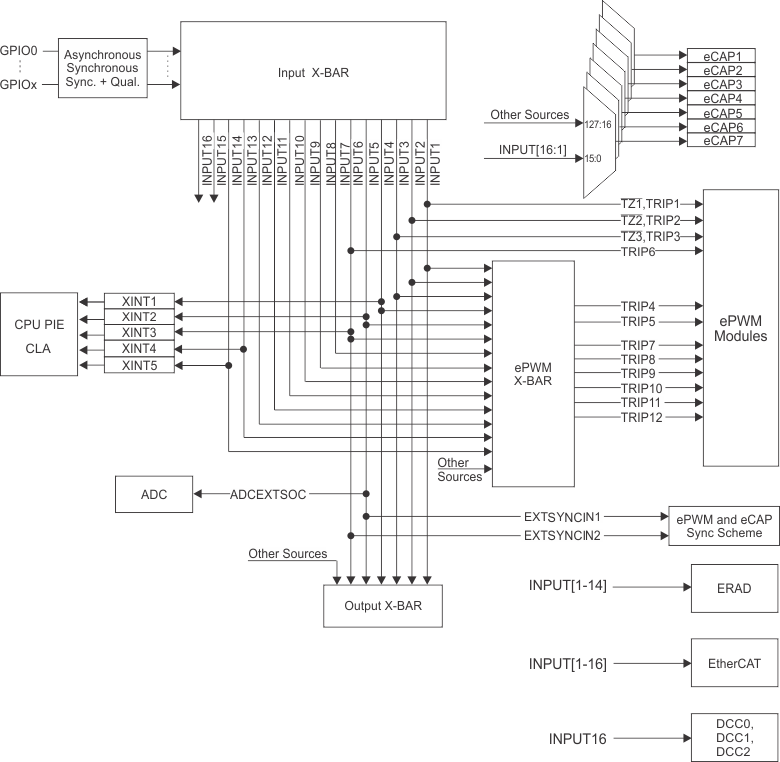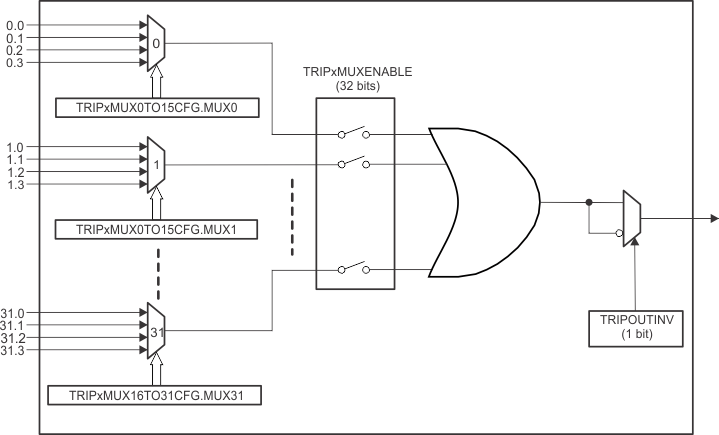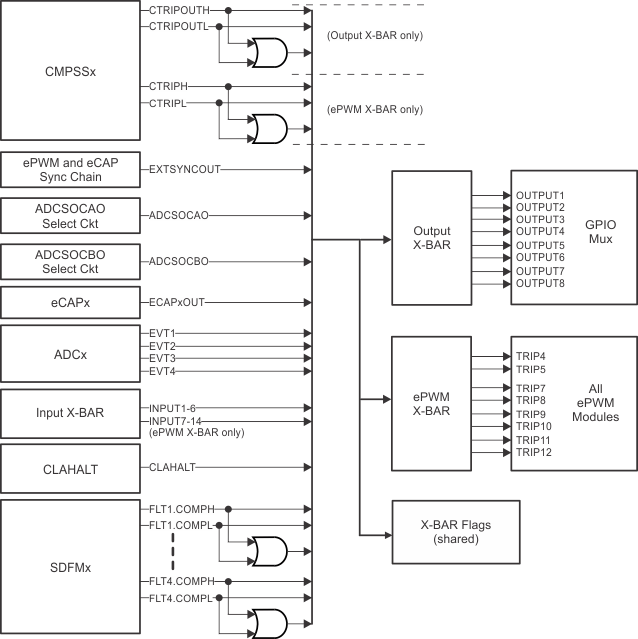SPRACN0F October 2021 – March 2023 F29H850TU , F29H859TU-Q1 , TMS320F280021 , TMS320F280021-Q1 , TMS320F280023 , TMS320F280023-Q1 , TMS320F280023C , TMS320F280025 , TMS320F280025-Q1 , TMS320F280025C , TMS320F280025C-Q1 , TMS320F280033 , TMS320F280034 , TMS320F280034-Q1 , TMS320F280036-Q1 , TMS320F280036C-Q1 , TMS320F280037 , TMS320F280037-Q1 , TMS320F280037C , TMS320F280037C-Q1 , TMS320F280038-Q1 , TMS320F280038C-Q1 , TMS320F280039 , TMS320F280039-Q1 , TMS320F280039C , TMS320F280039C-Q1 , TMS320F280040-Q1 , TMS320F280040C-Q1 , TMS320F280041 , TMS320F280041-Q1 , TMS320F280041C , TMS320F280041C-Q1 , TMS320F280045 , TMS320F280048-Q1 , TMS320F280048C-Q1 , TMS320F280049 , TMS320F280049-Q1 , TMS320F280049C , TMS320F280049C-Q1 , TMS320F28374D , TMS320F28374S , TMS320F28375D , TMS320F28375S , TMS320F28375S-Q1 , TMS320F28376D , TMS320F28376S , TMS320F28377S , TMS320F28377S-Q1 , TMS320F28378D , TMS320F28378S , TMS320F28379D , TMS320F28379D-Q1 , TMS320F28379S , TMS320F28384D , TMS320F28384S , TMS320F28386D , TMS320F28386S , TMS320F28388D , TMS320F28388S , TMS320F28P650DH , TMS320F28P650DK , TMS320F28P650SH , TMS320F28P650SK , TMS320F28P659DH-Q1 , TMS320F28P659DK-Q1 , TMS320F28P659SH-Q1
- The Essential Guide for Developing With C2000™ Real-Time Microcontrollers
- Trademarks
- 1C2000 and Real-Time Control
-
2Sensing Key Technologies
- 2.1 Accurate Digital Domain Representation of Analog Signals
- 2.2 Optimizing Acquisition Time vs Circuit Complexity for Analog Inputs
- 2.3 Hardware Based Monitoring of Dual-Thresholds Using a Single Pin Reference
- 2.4 Resolving Tolerance and Aging Effects During ADC Sampling
- 2.5 Realizing Rotary Sensing Solutions Using C2000 Configurable Logic Block
- 2.6 Smart Sensing Across An Isolation Boundary
- 2.7 Enabling Intra-Period Updates in High Bandwidth Control Topologies
- 2.8 Accurate Monitoring of Real-Time Control System Events Without the Need for Signal Conditioning
-
3Processing Key Technologies
- 3.1 Accelerated Trigonometric Math Functions
- 3.2 Fast Onboard Integer Division
- 3.3 Hardware Support for Double-Precision Floating-Point Operations
- 3.4 Increasing Control Loop Bandwidth With An Independent Processing Unit
- 3.5 Flexible System Interconnect: C2000 X-Bar
- 3.6 Improving Control Performance With Nonlinear PID Control
- 3.7 Understanding Flash Memory Performance In Real-Time Control Applications
- 3.8 Deterministic Program Execution With the C28x DSP Core
- 3.9 Efficient Live Firmware Updates (LFU) and Firmware Over-The-Air (FOTA) updates
-
4Control Key Technologies
- 4.1 Reducing Limit Cycling in Control Systems With C2000 HRPWMs
- 4.2 Shoot Through Prevention for Current Control Topologies With Configurable Deadband
- 4.3 On-Chip Hardware Customization Using the C2000 Configurable Logic Block
- 4.4 Fast Detection of Over and Under Currents and Voltages
- 4.5 Improving System Power Density With High Resolution Phase Control
- 4.6 Safe and Optimized PWM Updates in High-Frequency, Multi-Phase and Variable Frequency Topologies
- 4.7 Solving Event Synchronization Across Multiple Controllers in Decentralized Control Systems
- 5Interface Key Technologies
- 6Safety Key Technologies
- 7References
- 8Revision History
3.5.2 In Depth
The inter-dependence of the Sensing and Actuation subsystems in a real-time control MCU is an obvious one. Whether it is incoming signals into the device, signals generated by on-chip logic (comparator, SDFM, ADC, and so forth), or outgoing signals; routing these signals in the system can be challenging at best. The on-chip X-bars provide a flexible mechanism to do that in hardware inside the MCU. There are three key benefits that these modules provide to the system:
- Simple routing of external signals into the chip: Any GPIO can
go to multiple modules on-chip (#T5843526-24). For example, this allows the eCAP module to choose from any input pin as
its source, or any input pin to go to the CPU/CLA as an external interrupt. This
also gives flexibility in signal routing and layout of the Printed Circuit Board
(PCB) since pins are not hard configured for a set group of functions.
 Figure 3-7 Input X-Bar on the
TMS320F2837xD MCU
Figure 3-7 Input X-Bar on the
TMS320F2837xD MCU - Lower system latency: For simple point-to-point transactions,
there is no need for the main C28x CPU or the CLA to spend cycles routing
signals from one domain to another when using the X-bars. Inside of each X-bar,
there is also a simple logical OR (#T5843526-34) that allows combination of any of the inputs to the X-bar in hardware. This
not only saves cycles for the processors, but allows flexibility of the system
since the mux selections are all controlled in software and can be changed
dynamically as needed.
 Figure 3-8 Local Mux and Logical
OR on the TMS320F2837xD MCU
Figure 3-8 Local Mux and Logical
OR on the TMS320F2837xD MCU - Consistent timing: Similar to the above, since there is no CPU
involvement, the signal propagates at the system clock in real time as it
happens and is not contingent on another block to allow the signal to pass
(#T5843526-25). This results in more predictable and repeatable system behavior. Given that
the nature of many of the signals is to pass into the actuation sub-system
timing is especially critical.
 Figure 3-9 X-Bar Sources and
Destinations on the TMS320F2837xD MCU
Figure 3-9 X-Bar Sources and
Destinations on the TMS320F2837xD MCU